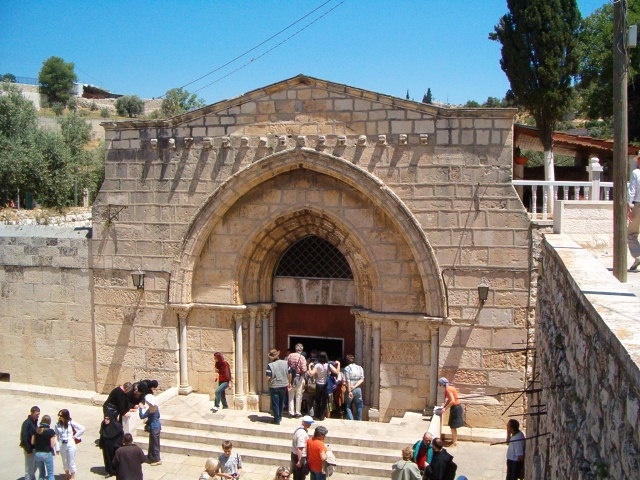Tomb of the Virgin Mary │Church of the Sepulchre of Saint Mary
Tomb of the Virgin Mary or Church of the Sepulchre of Saint Mary, also Tomb of the Virgin Mary, is a Christian tomb in the Kidron Valley – at the foot of Mount of Olives, in Jerusalem – believed by Eastern Christians to be the burial place of Mary, the mother of Jesus.
History
The Sacred Tradition of Eastern Christianity teaches that the Virgin Mary died a natural death (the Dormition of the Theotokos, the falling asleep), like any human being; that her soul was received by Christ upon death; and that her body was resurrected on the third day after her repose, at which time she was taken up, soul and body, into heaven in anticipation of the general resurrection. Her tomb, according to this teaching, was found empty on the third day.
Roman Catholic teaching holds that Mary was “assumed” into heaven in bodily form, the Assumption; the question of whether or not Mary actually underwent physical death remains open in the Catholic view.
A narrative known as the Euthymiaca Historia (written probably by Cyril of Scythopolis in the 5th century) relates how the Emperor Marcian and his wife, Pulcheria, requested the relics of the Virgin Mary from Juvenal, the Patriarch of Jerusalem, while he was attending the Council of Chalcedon (451). According to the account, Juvenal replied that, on the third day after her burial, Mary’s tomb was discovered to be empty, only her shroud being preserved in the church of Gethsemane. In 452 the shroud was sent to Constantinople, where it was kept in the Church of Our Lady of Blachernae (Panagia Blacherniotissa).
According to other traditions, it was the Cincture of the Virgin Mary which was left behind in the tomb or dropped by her during Assumption.
The church

Preceded by a walled courtyard to the south, the cruciform church shielding the tomb has been excavated in an underground rock-cut cave entered by a wide descending stair dating from the 12th century. On the right side of the staircase (towards the east) there is the chapel of Mary’s parents, Joachim and Anne, initially built to hold the tomb of Queen Melisende of Jerusalem, the daughter of Baldwin II, whose sarcophagus has been removed from there by the Greek Orthodox. On the left (towards the west) there is the chapel of Saint Joseph, Mary’s husband, initially built as the tomb of two other female relatives of Baldwin II.
On the eastern side of the church there is the chapel of Mary’s tomb. Altars of the Greeks and Armenians also own the east apse. A niche south of the tomb is a mihrab indicating the direction of Mecca, installed when Muslims had joint rights to the church. Currently the Muslims have no more ownership rights to this site. On the western side there is a Coptic altar.
The Armenian Patriarchate Armenian Apostolic Church of Jerusalem and Greek Orthodox Church of Jerusalem are in possession of the shrine. The Syriacs, the Copts, and the Ethiopians have minor rights.
Source : wikipedia
https://www.youtube.com/watch?v=nkGDCnrMnRU
https://www.youtube.com/watch?v=u8WmIP-fQMc
https://www.youtube.com/watch?v=9U37qaygz8c
Reviews
https://goo.gl/gG0Glp



Rate this article